253 series
The 253 series (253系) is a DC electric multiple unit (EMU) train type operated by East Japan Railway Company (JR East). It was introduced on 19 March 1991 for use exclusively on the Narita Express, a limited express service linking Narita International Airport with stations in the Tokyo area. The 253 series trains were withdrawn from Narita Express services on 30 June 2010,[1] with two trains redeployed on Nikkō and Kinugawa limited express services from June 2011.
| 253 series | |
|---|---|
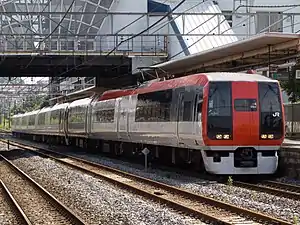 A 253 series train on a Narita Express service in June 2008 | |
| In service | 1991–present |
| Manufacturer | Kinki Sharyo, Tokyu Car Corporation |
| Replaced | 189 series, 485 series (Nikkō sets only) |
| Constructed | 1990–2002 |
| Entered service | 19 March 1991 |
| Refurbished | 2010 |
| Number built | 111 vehicles |
| Number in service | 12 cars (2 sets) |
| Number scrapped | 93 |
| Successor | E259 series (Narita Express) |
| Formation | 6 cars per trainset (3 cars in the past) |
| Operator(s) | JR East |
| Depot(s) | Omiya |
| Line(s) served | Yamanote Freight Line, Tohoku Main Line, Tobu Nikko Line |
| Specifications | |
| Car body construction | Steel |
| Car length | 20,930 mm (68 ft 8 in) (end cars) 20,500 mm (67 ft 3 in) (intermediate cars) |
| Width | 2,946 mm (9 ft 8.0 in) |
| Doors | 2 per side |
| Maximum speed | 130 km/h (81 mph) |
| Traction system | Resistor control + field system superimposed field excitation control (253-0/200 series) Variable frequency (IGBT) (253-1000 series) |
| Electric system(s) | 1,500 V DC |
| Current collector(s) | Overhead wire |
| Bogies | DT69, TR254 (253-200 series only) |
| Braking system(s) | Regenerative brake, electronically controlled pneumatic brakes |
| Safety system(s) | ATS-P, ATS-SN, ATC-5 (not used), Tōbu ATS (253-1000 series only) |
| Track gauge | 1,067 mm (3 ft 6 in) |
Design
The design was overseen by industrial designer Kenji Ekuan,[2] and the trains were manufactured by Kinki Sharyo and Tokyu Car Corporation.[3] Sets were formed as three-car and six-car units, running as up to 12-car formations in service. From 1 October 2009, all three-car sets were removed from Narita Express operations.[4]
It was the recipient of the 32nd Laurel Prize of the Japan Railfan Club. Extra sets were built in 2002 to cope with the increase in traffic during the 2002 FIFA World Cup. These sets were classified 253-200 series, and included minor improvements over the original 253-0 and 253-100 series sets, such as LED destination indicators, conventional rotating seats in standard class, and 2+1 seating in Green Cars.
Operations
Nikkō/Kinugawa (from June 2011)
Narita Express (1991–2010)
Variants
1st batch
63 coaches (21 trains in three-car formation) were manufactured in 1990 and entered service in 1991. The types of coaches were the KuRo 253 (Green Car driving trailer), MoHa 253 (trailer) and KuMoHa 252 (driving trailer) coaches. Three-car sets were sometimes joined to form six-car formations.
2nd-4th batches
36 coaches were manufactured in 1992 to 1996 to cope with an increase in passenger traffic on the Narita Express, eventually enabling the 253 series trains to run in 12-car formations as well as the older 3/6-car formations. Minor changes were observed in the interior, notably that the seats had two colours, black and red.
5th batch
The fifth batch of 253 series trains (classified 253-200 series) consisting of two six-car sets, Ne201 and Ne202, were delivered from Tokyu Car in 2002 in anticipation of the 2002 FIFA World Cup which was expected to further increase passenger traffic on the Narita Express. Variable frequency traction systems were built into these trains, and they were fitted with DT69 and TR254 bogies. The interior differed from previous batches, with LED destination indicators, conventional rotating seats in standard class, and 2+1 seating in Green cars.
Formations
6-car sets Ne01–11

| Car No. | 1 | 2 | 3 | 4 | 5 | 6 |
|---|---|---|---|---|---|---|
| Designation | M'c | M | T | M' | M1 | Tsc |
| Numbering | KuMoHa 252 | MoHa 253 | SaHa 253 | MoHa 252 | MoHa 253-100 | KuRo 253 |
6-car set Ne101
| Car No. | 1 | 2 | 3 | 4 | 5 | 6 |
|---|---|---|---|---|---|---|
| Designation | M'c | M | T | M' | M1 | Tsc |
| Numbering | KuMoHa 252 | MoHa 253 | SaHa 253 | MoHa 252 | MoHa 253-100 | KuRo 253-100 |
3-car sets Ne102–110
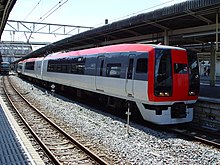
| Car No. | 1 | 2 | 3 |
|---|---|---|---|
| Designation | M'c | M | TsRc |
| Numbering | KuMoHa 252 | MoHa 253 | KuRoHa 253 |
6-car sets Ne201–202

| Car No. | 1 | 2 | 3 | 4 | 5 | 6 |
|---|---|---|---|---|---|---|
| Designation | M'c | M | T | M' | M1 | Tsc |
| Numbering | KuMoHa 252-200 | MoHa 253-200 | SaHa 253-200 | MoHa 252-200 | MoHa 253-300 | KuRo 253-200 |
Each MoHa 253 car was equipped with one PS26 lozenge-type pantograph.[5]
 KuMoHa 252
KuMoHa 252 MoHa 253
MoHa 253 SaHa 253
SaHa 253 MoHa 252
MoHa 252 MoHa 253-100
MoHa 253-100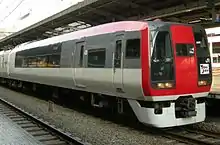 KuRo 253
KuRo 253
Interior
The standard-class seating arrangement used in the original 253 series sets was unusual for Japanese limited express trains in consisting of European-style fixed four-seat bays. The seats were later rearranged in a fixed unidirectional layout facing four-seat bays in the centre of each car between 2003 and 2004. The green (first class) cars in the original three-car sets were classified as KuRo 253 or KuRo 253-100.[6] The KuRo 253 cars had ten rows of 1+1 seating at a seat pitch of 1,090 mm (43 in), with seats angled to face the windows, together with one 4-person compartment.[6] The KuRo 253-100 cars had eight rows of seats arranged in a mixture of 2+1 and 1+1 at a seat pitch of 1,340 mm (53 in), together with one 4-person compartment.[6]
 General view of standard-class saloon with fixed unidirectional seating
General view of standard-class saloon with fixed unidirectional seating Standard-class fixed seating
Standard-class fixed seating Standard-class rotating seating
Standard-class rotating seating General view of Green-class saloon
General view of Green-class saloon Green-class compartment in November 2007
Green-class compartment in November 2007
Retirement
The 253 series trains were gradually replaced on Narita Express services from October 2009 by new E259 series EMUs, with the last trains operating until 30 June 2010.[1][7] Most trains were subsequently withdrawn and scrapped, but two six-car sets, Ne201 and Ne202, were converted in late 2010 to become 253-1000 series (see below), and two three-car sets, Ne107 and Ne108, were sold to the Nagano Electric Railway (see below).
253-1000 series
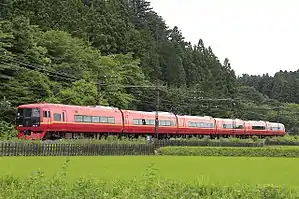
The two newest-built sets, Ne201 and Ne202, underwent extensive refurbishment at JR East's Omiya Works and Tokyu Car Corporation's Yokohama factory to become 253-1000 series sets OM-N1 and OM-N2 for use on Nikkō and Kinugawa limited express services jointly operated with Tobu Railway from 4 June 2011, replacing the 485 series and 189 series EMUs currently used.[8] Refurbishment includes entirely new interiors with monoclass seating configured with seat pitch increased from 1,020 mm to 1,100 mm, as well as replacement of main equipment. The total seating capacity for each six-car set is 290. Onboard announcements and passenger information displays is in four languages, Japanese, English, Chinese, and Korean.[9]
Formation
The 253-1000 series sets are formed as follows.[10]
| Car No. | 1 | 2 | 3 | 4 | 5 | 6 |
|---|---|---|---|---|---|---|
| Designation | M'c | M2 | M' | M3 | T | Tc |
| Numbering | KuMoHa 252-1000 | MoHa 253-1000 | MoHa 252-1000 | MoHa 253-1100 | SaHa 253-1000 | KuHa 253-1000 |
| Capacity | 48 | 42 | 56 | 48 | 56 | 40 |
| Weight (t) | 39.6 | 40.2 | 36.6 | 39.9 | 29.1 | 34.3 |
The M2 and M3 cars are each fitted with one PS26A lozenge-type pantograph.
 KuMoHa 252-1000
KuMoHa 252-1000 MoHa 253-1000
MoHa 253-1000 MoHa 252-1000
MoHa 252-1000 MoHa 253-1100
MoHa 253-1100 SaHa 253-1000
SaHa 253-1000 KuHa 253-1000
KuHa 253-1000
Interior
 The interior of car 6 in June 2013
The interior of car 6 in June 2013 The interior of car 3 in September 2016
The interior of car 3 in September 2016
Resale
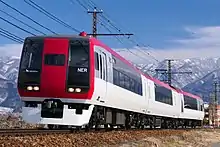
Two three-car sets, Ne107 and Ne108, were sold to the Nagano Electric Railway for use on new Snow Monkey limited express services. The two sets, reclassified as 2100 series, entered service from February 2011 after modifications to allow wanman driver only operation.[11]
Other appearances
The 253 series was featured in the train simulator Densha de Go! Final also in Densha De Go! Pocket Chuo line which runs on a (real-life) once-daily Narita Express service on the Chūō Main Line from Takao Station to Shinjuku Station.
References
- 253系 成田エクスプレス引退記念入場券の発売について (Sale of platform tickets commemorating retirement of 253 series Narita Express) (PDF). jrchiba.jp (in Japanese). JR East, Chiba Branch. 27 May 2010. Archived from the original (PDF) on 1 June 2010. Retrieved 3 June 2010.
- "The Works of GK Design Group". gk-design.co.jp. GK Design Group Inc. Archived from the original on 17 February 2015. Retrieved 10 February 2015.
- Saka, Masahiro (March 2014). JR第1世代の車両・現況と概要 [JR 1st-generation rolling stock: Current situation and overview]. Tetsudō Daiya Jōhō Magazine (in Japanese). 43 (359): 22.
- JR Timetable, October 2009
- JR電車編成表 '07冬号 [JR EMU Formations – Winter 2007]. Japan: JRR. December 2006. pp. 84–85. ISBN 978-4-88283-046-7.
- 成田エクスプレス253系特急形電車 ["Narita Express" 253 series limited express EMU]. Railway Journal (in Japanese). 25 (293): 88–91. March 1991.
- JR東日本 E259系特急型直流電車 [JR East E259 series limited express DC EMU]. Tetsudō Daiya Jōhō. 38 (303): 70–71. July 2009.
- "253系1000番台OM-N01編成が試運転" [253-1000 series set OM-N01 undergoing test-running]. Japan Railfan Magazine Online (in Japanese). Japan: Koyusha Co., Ltd. 22 May 2011. Retrieved 23 May 2011.
- 特急〈日光〉〈きぬがわ〉に253系リニューアル車投入へ [Refurbished 253 series to be introduced on "Nikko" and "Kinugawa" limited expresses]. Tetsudo Hobidas (in Japanese). Japan: Neko Publishing. 17 November 2010. Archived from the original on 19 November 2010. Retrieved 17 November 2010.
- JR東日本 253系1000番代特急型直流電車 [JR East 253-1000 series DC limited express EMU]. Tetsudō Daiya Jōhō Magazine. 40 (323): 74–75. March 2011.
- 新型特急車両の導入について [Introduction of new limited express trains]. nagaden-net.co.jp (in Japanese). Nagano Electric Railway. 3 June 2010. Archived from the original on 30 March 2010. Retrieved 3 June 2010.
External links
- JR East 253 series Nikko / Kunugawa (in Japanese)